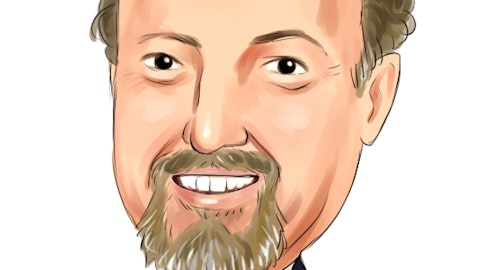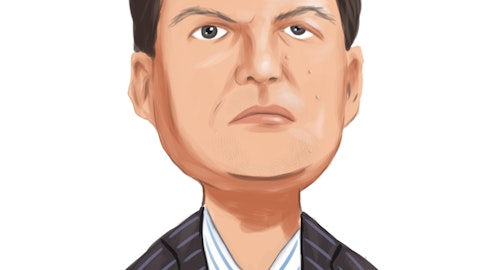PacWest Bancorp (NASDAQ:PACW) Q4 2023 Earnings Call Transcript January 25, 2024
PacWest Bancorp isn’t one of the 30 most popular stocks among hedge funds at the end of the third quarter (see the details here).
Operator: Hello, and welcome to Banc of California’s Fourth Quarter Earnings Conference Call. All participants will be in a listen-only mode. [Operator Instructions] After today’s presentation, there will be an opportunity to ask question. [Operator Instructions] Today’s call is being recorded, and a copy of the recording will be available later today on the company’s Investor Relations website. Today’s presentation will also include non-GAAP measures. The reconciliation for these and additional required information is available in the earnings press release, which is available on the company’s Investor Relations website. The reference presentation is also available on the company’s Investor Relations website. Before we begin, we would like to direct everyone to the company’s safe harbor statement on forward-looking statements included in both the earnings release in the earnings presentation.
At this time, I’d like to turn the floor over to Mr. Jared Wolff, Banc of California’s President and Chief Executive Officer.
Jared Wolff: Good morning. Welcome to Banc of California’s fourth quarter earnings call. Joining me on today’s call are Joe Kauder, our CFO; and our Bill Black, our Head of Strategy. Our investor presentation, along with our earnings release, were designed to provide a great deal of information given the unusual nature of the fourth quarter, which was impacted by the closing of the merger and several one-time items related to our balance sheet repositioning actions. We aren’t going to do a detailed walk-through of the changes in various line items from the prior quarter. Instead, we’ll utilize the time on our call today to introduce the new Banc of California, provide an update on the progress we have made on the balance sheet repositioning and lay out the timing for our integration and provide insight into the key financial metrics for Q1 and beyond.
We’ll be happy to answer any specific questions to our fourth quarter results later in the call. I’m truly thrilled that we delivered on so many of the key objectives that we outlined when we announced the deal. Thanks to the hard work of our talented colleagues and advisers and the work of the regulators, we received approval for our transaction in record time and closed the transaction on the front end of our range. We delivered CET1 on top of our 10% target, notwithstanding a complicated rate environment and considerable moving items on the balance sheet. And we nearly hit $15 in tangible book value, after guiding to the mid-to-low $14 range when we announced Q3 earnings. Many other key metrics were delivered in line as well. Since closing the merger on November 30, our team has been collaborating exceptionally well, and we’ve made excellent progress on the balance sheet repositioning actions that we indicated at the time of the merger announcement.
As a result, we have created the well-capitalized highly liquid financial institution with strong earnings power and a strong position in California as we envisioned. Today, we are the third largest bank headquartered in California based on assets with an enviable presence up and down the state, clean credit and an exceptionally talented team of colleagues who are focused on serving businesses with high-touch service and tailored solutions that our target clients aren’t getting from others. The closing of our merger reflected the relentless execution that Banc of California has become known for. Among the most notable items, we completed the planned sales of legacy Banc of California’s $1.7 billion SFR portfolio. Approximately $700 million of the multifamily portfolio and $1.2 billion of the investment portfolio as well as approximately $2 billion of PacWest securities.
The proceeds along with the excess cash from PacWest were utilized to reduce the higher-cost wholesale funding on the balance sheet. We retired the $1.3 billion repurchase agreement with Atlas and have also continued to reduce the volume of higher cost broker deposits, which are down nearly $4 billion from the time of the merger announcement through the end of 2023. We also repaid $2.3 billion of the bank term funding program balance, choosing to retain a portion in order to maintain a higher level of liquidity and pay down higher cost broker deposits. In total, we sold approximately $6 billion of assets with an average yield of 3.6%. And paid down approximately $9 billion of wholesale funding with an average cost of 5.2%, contributing more than $90 million annually to the net interest margin.
This was nearly all completed in the month of December. As mentioned, we decided to retain a portion of our multifamily portfolio, rather than selling the entire portfolio as originally planned. These are well performing loans. And after the purchase accounting mark, they have attractive yields in an approximately four-year effective duration that we determine we’re in our best interest to retain given the outlook for potentially declining rates. As noted, we were able to execute on most of our planned balance sheet repositioning actions in a short period of time, strengthening our balance sheet and repositioning the company for improved performance and enhance flexibility. We will continue to evaluate all available options as we seek to optimize our balance sheet going forward.
We have also started to see some of the potential benefits that we believed we would have following the merger. With the strength of the restructured balance sheet and superior level of service that we can provide, we have started to bring back many of the operating deposit accounts of PacWest clients that left the bank during the turmoil early last year. We also felt that there would be opportunities to further capitalize on our position as a talent magnet. We have already added a number of individuals and will look to continue adding exceptional banking talent that we believe can positively contribute to the profitable growth of our franchise in the coming years. Now let me hand it over to Joe, who will provide some additional financial information, and I’ll have some closing remarks before opening up the line for questions.
Joe?
Joe Kauder: Thank you, Jared. I’m going to start by providing the spot rates for balance sheet items as of December 31 to provide some visibility to our net interest margin for the first quarter. As of December 31, 2023, our estimated spot rate for loan yields was 6.18%. Our estimated spot rate for the yield of all interest-earning assets was 5.63%. Our spot rate for the cost of deposits was 2.69%. Our spot rate for the cost of funds was 2.99%, and our estimated spot rate for our net interest margin was 2.75%, compared to 1.69% for the fourth quarter and 2.15% for the month of December of 2023. We are exiting the quarter with a much higher net interest margin due to the benefits of the merger and our balance sheet repositioning actions.

And we expect our first quarter net interest margin to approach 3%. The expected increase in our net interest margin in the first quarter from December 31 spot rate will be driven by an approximate 15 basis point improvement in earning asset yields, driven mostly by loan repricing and new originations at higher rates currently between 7% and 8% and an approximate 10 basis point improvement in cost of funds driven by the paydown of higher cost wholesale funding and an increase in the relative percentage of lower cost core deposits. Putting aside changes in interest rates, we expect to see a steady decline in our interest expense as we move through 2024 and continue to replace higher cost wholesale funding sources with lower cost deposits acquired through our business development efforts.
There are also some additional actions that we may take that could have a positive impact on our net interest margin, including additional asset sales and using off-balance sheet options for higher cost customer deposits. At this point, we are moderately liability-sensitive and will benefit from a reduction in interest rates. Once we have completed our balance sheet repositioning, including reaching our internal targets for low-cost deposits, we intend to manage the bank to a neutral or slightly asset-sensitive position. Looking at noninterest expense, it will be reasonable to expect our first quarter 2024 OpEx ratio to be in the range of 210% to 220%. As we have indicated previously, the expected cost savings from the merger will be phased in over the course of 2024.
Major contributors to the cost savings include the completion of the systems conversion, which is scheduled to incur in May, a reduction in FDIC assessment expense, which we anticipate to start declining in the first quarter and office consolidation with approximately 18% of the leases on PacWest offices expiring during 2024. By the fourth quarter of 2024, we expect our OpEx ratio to be down around 2.0% and we are targeting the quarterly run rate for noninterest expense to be approximately or below 2% of total assets from that point forward. With all of the integration and balance sheet repositioning actions proceeding on schedule, the guidance we provided for a level of returns that we announced at the time of the merger has not changed. Rather than focusing on the full year, our primary focus is on ensuring our ending Q4 run rate is in line with our targets of approximately 1.10% ROAA and 13% ROTCE.
Given the timing of achieving cost savings throughout the year. At this time, I’ll turn the call back over to Jared.
Jared Wolff: Thanks, Joe. I’d like to wrap up with some comments around our vision we have for the company and the broader outlook. We are organized around two primary areas. First, the bulk of our assets are centered in our Community Bank, which is comprised of our talented bankers who focus on in-market relationship lending across California, in Denver, Colorado, in Durham, North Carolina and a few other locations. We provide full-service commercial banking across real estate and C&I, including asset-based lending. Paired with our Community Bank, our specialty lines, which provide expertise in specific verticals, including homeowners and property management solutions, media and entertainment, warehouse lending, corporate asset finance, SBA, fund finance and venture banking.
Whether in our community or specialty areas, we offer best-in-class depository and treasury management solutions, corporate asset management and the payments ecosystem we are building, which includes merchant processing, card solutions as an issuer and third-party processing. We believe we have great market position in California, given the strength of our franchise and superior level of service and expertise that we can provide. Particularly given the significant changes we have seen over the past few years in the California banking market with so many of our competitors exiting or significantly pulling back from the market. We believe this presents us with significant opportunities to consistently add attractive new client relationships that provide low-cost deposits and high-quality loans.
And as we continue to build out our new payments ecosystem, which we believe will only further enhance our value proposition, it will differentiate us from competing banks and positively impact our business development efforts. As we’ve indicated, we expect to be a high-performing institution with strong earnings power. A portion of that will come from restoring the high level of profitability that PacWest businesses have historically generated. In recent years, there were some lower-yielding assets added that were funded with higher cost funding sources that negatively impacted PacWest historical profitability. With the balance sheet repositioning actions we have taken, we have significantly reduced these assets and funding sources, which creates a path to a higher level of returns for the combined institution.
As we start 2024, while there remains some degree of economic uncertainty, we are already seeing the positive impact of being a larger, stronger financial institution on our loan production with a greater volume of opportunities for us to consider. We’re seeing a reasonable level of loan demand, which is enabling us to generate a meaningful level of new loan production while continuing to be conservative and highly selective in the loans we choose to make. In most cases, loans coming on the books are being done at the same or higher rates than those paying off. Given the volume of runoff we anticipate, while there is some uncertainty regarding the pace and the timing. At this point, we are expecting to end 2024 with total loan balances that are flat to slightly down from the year-end 2023 level and then growing during 2025 as economic conditions improve.
As we move through 2024, we will provide an update to our expectations based on any changes we see in economic conditions that have a material impact on loan demand and loan production. Regardless of the rate curve and pace of changes in interest rates, we are well positioned to capitalize on such opportunity, given the highly liquid balance sheet that we now have. I want to note that we feel very good about the credit quality of the loan portfolio. The merger process dictated that we take a close look at every loan in the portfolio of each legacy bank and make sure that they were appropriately rated as well as resolve some of the weaker credits. As a result, the bank has cleaner credit and a higher level of reserves following the provision that we recorded in the fourth quarter.
And from an asset quality standpoint, we are comfortable with where we stand. It’s fair to say that based on our Q4 actions, the new Banc of California has cleaner credit today than either of its predecessors. I want to specifically thank the dedicated and talented colleagues at Banc of California for their amazing efforts, contributions and many sacrifices for helping to create this new and exciting franchise. I have witnessed heroic undertakings, and I feel very privileged to be leading such an incredible group of colleagues. Thanks to all of them, I’m confident in what we have set out to accomplish this year and beyond. In closing, we believe we are well positioned to deliver strong financial performance for our shareholders in 2024 as well as to capitalize on our great market position that we have built in California to consistently enhance the value of our franchise in the coming years.
With that, operator, let’s go ahead and open up the line.
See also 40 Accredited Online Business Degree Programs Heading Into 2024 and 24 Least Developed Countries in Asia in 2024.
Q&A Session
Follow Pacwest Bancorp (NASDAQ:PACW)
Follow Pacwest Bancorp (NASDAQ:PACW)
Operator: Ladies and gentlemen, at this time, we will begin the question-and-answer session. [Operator Instructions] And our first question today comes from Matthew Clark from Piper Sandler. Please go ahead with your question.
Matthew Clark: Hi guys. How are you doing?
Jared Wolff: Good morning. Great.
Matthew Clark: Good. Just wanted to start on expenses for the upcoming quarter and the related run rate? I know you had a kind of partial quarter in 4Q, and you get kind of another month of legacy of Banc or two months of legacy Banc. But can you speak to not only kind of where that run rate might shake out ex merger charges, but how much in the way of cost saves have you realized so far and how much are left?
Jared Wolff: We have a lot left to do, which is why we think that in the first quarter, the OpEx ratio is going to be between 210 and 220. And the glide path will be getting down to by the end of Q4. The conversion isn’t going to take place until May. And there’s a number of things that come out after that across the company. Joe mentioned the facilities. We are going to get a lift from the FDIC assessment that we think will be reduced beginning in the first quarter. But there’s a lot to take out that’s going to come later in the year. Joe, I don’t know if you have more color there.
Joe Kauder: Yes. No, I think you captured it correctly. I think we have a – we manage a detailed list of savings initiatives. We have our plans in place, and the big initiatives that Jared spoke to are some of the larger ones we do expect to get the FDIC assessment favorability in the first quarter. And we’ll see it start coming out from there.
Jared Wolff: Matthew, we literally have a list of like 30 things with a person assigned the deadline by which it’s supposed to get done and the impact. And we’re going through that list and check them off as we go. And we’re not going to lose track of them, and they’re all within our control, we believe. In addition to that, we obviously have the expense savings we think we can realize on the interest side by being proactive about making sure deposit costs are appropriate. We don’t need to pay necessarily the same levels we’re paying in the past given the strength of the franchise, but we want to protect relationships. And a lot of that’s going to be the – based on the volume of new relationships that we bring in and new deposits that come back to the bank.
I solicited feedback for this call from a number of our colleagues and I ask them to share client wins and stories of clients coming back beyond what I already knew about. And I got my inbox was full of stories of people talking about this client had $2 million and with tears in their eyes, they moved it out during the problems of early 2023, and they just brought it back. They weren’t happy at BofA or wherever they went and they brought it all back. And so there’s a lot of stories like that. But that’s going to take place over the course of the year and that will impact our ability to improve our interest expense as well.
Matthew Clark: Got it. And then just on earning assets, trying to get a better sense of where those balances might be coming into the year here. You spoke to the loan piece of it for the year, but just knowing that you still have BTFP and some more brokered cities than you probably would like to have. How should we think about overall average earning assets this year?
Jared Wolff: Well, the fed made our decision really easy on BTFP, right, with the announcement yesterday in terms of jacking the cost at the end of March. So I’m sure we’ll probably get out of it by then, if not before. Joe, what’s your sense for where our average earning assets will be?
Joe Kauder: I think they’re going to be pretty flat for the year, and you may see the balance sheet just shrinking a little bit with the excess liquidity that we have coming into the New Year being deployed against the BTFP or high cost deposits, depending on what the right decision is as we move forward. But the earning assets should be pretty stable.
Jared Wolff: Yes, we are going to prioritize profitability, as Joe rightly pointed out in the call. And so while our earning assets – while our assets say are total about 38.5%, it wouldn’t be surprising to get lower by the end of the year. But we’re not really focused on that. We’re focused on hitting our profitability targets regardless of the size of the balance sheet. And if it means we should be smaller, then we’ll be smaller. If it means, we’re comfortable being a little bit larger because we have the ability to earn at the profitability levels we said, then we won’t focus on it. But profitability is the number one goal.
Matthew Clark: Okay, great. And then last one for me. You got CET1 now over 10%, 10.12% and tangible common rebuilding probably pretty quickly here. I guess, what’s the appetite for a buyback with the stock below tangible book?
Jared Wolff: Well, we obviously believe that we’re going to be building up capital at a very healthy pace. And once we get to a level where we believe we have sufficient excess capital and that it’s sustainable at that level, we will certainly have a variety of options and they’re not mutually exclusive. We’re going to obviously continue to reinvest in our company while also looking at ways to reduce share count, whether it’s preferred or common. But I think it’s important that we demonstrate the sustainability of our capital and earnings and that we build it up to levels that we consider excess. And from there we’ll have plenty of options.
Matthew Clark: Great. Thanks again.
Jared Wolff: Thank you.
Operator: Our next question comes from Brandon King from Truist. Please go ahead with your question.
Brandon King: Hey, good afternoon.
Jared Wolff: Hey, Brandon.




